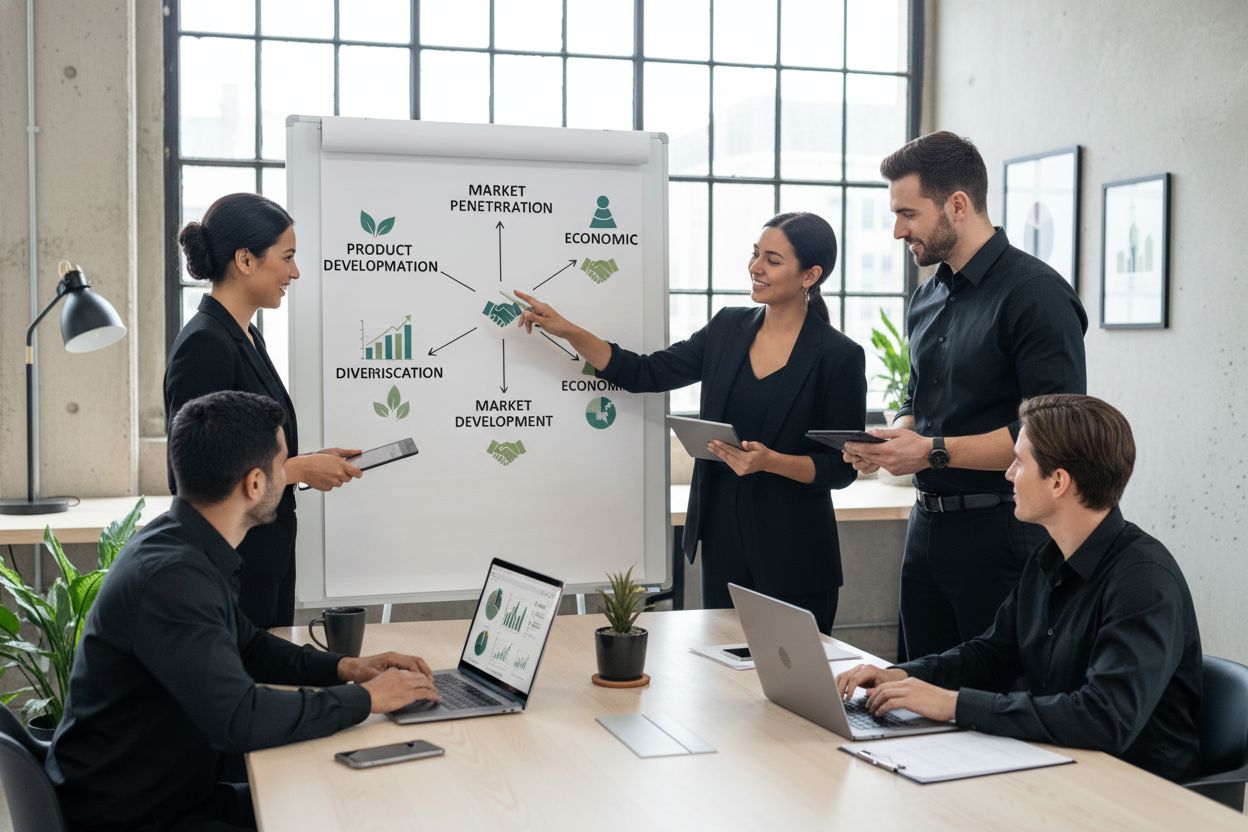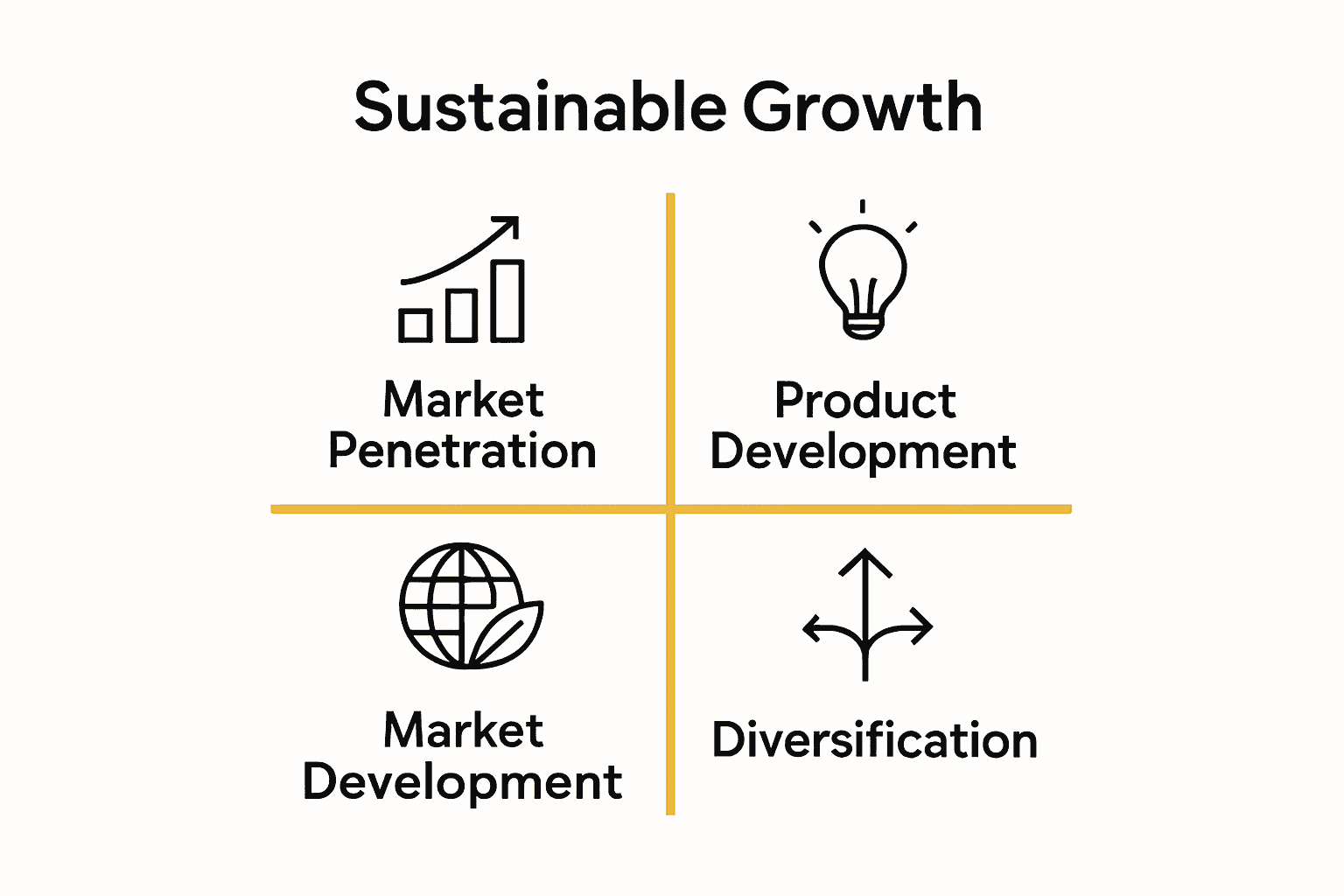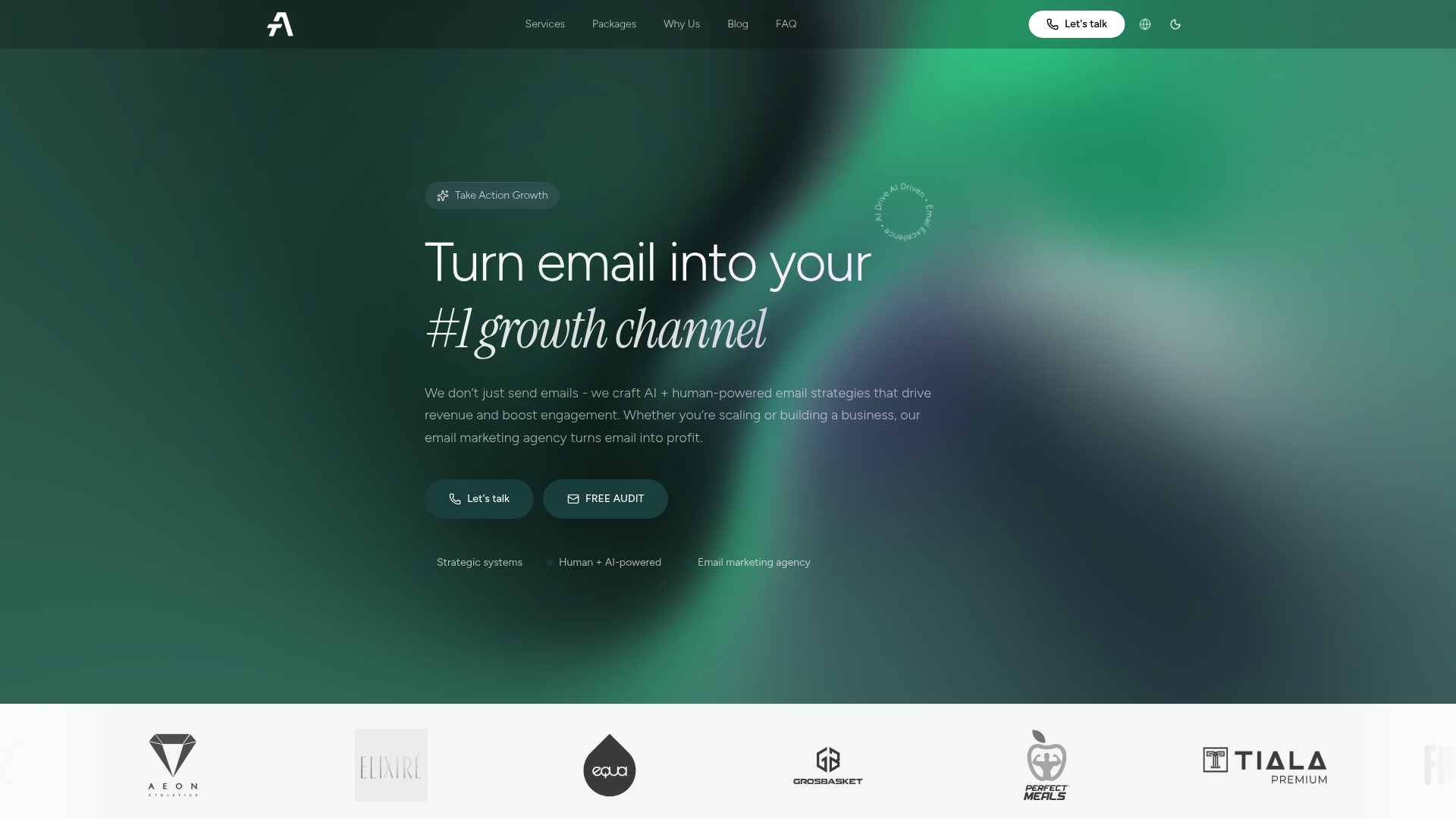Sustainable Business Growth: Complete Guide for Brands
More than 90 percent of executives say sustainability is important to their company’s future, yet many struggle to define what true sustainable growth really means. As pressure mounts for businesses to deliver more than just profits, understanding a model that blends financial success with environmental and social responsibility is no longer a luxury. Brands that master this balance are equipped to create lasting value and stronger connections in a changing world.
Table of Contents
- Defining Sustainable Business Growth Essentials
- Types of Sustainable Growth Strategies for Brands
- Key Levers: Automation, Retention, and Segmentation
- Integrating Klaviyo and Email-Driven Growth
- Common Mistakes and Success Factors
Key Takeaways
| Point | Details |
|---|---|
| Holistic Approach to Growth | Sustainable business growth balances financial performance with social and environmental responsibilities, prioritizing long-term value creation. |
| Strategic Growth Pathways | Brands can adopt various sustainable growth strategies like market penetration and diversification to ensure responsible development. |
| Key Levers for Success | Automation, customer retention, and audience segmentation are critical for enhancing operational efficiency and building lasting customer relationships. |
| Avoiding Common Pitfalls | Brands must resist short-termism and focus on integrating sustainability practices to create resilient and adaptive business models. |
Defining Sustainable Business Growth Essentials
Sustainable business growth isn’t just about financial performance—it’s a holistic approach that balances economic success with environmental and social responsibility. According to research from Wikipedia, sustainable business models aim to minimize negative impacts while achieving long-term organizational development through strategic innovation and responsible practices.
At its core, sustainable growth involves creating value that extends beyond immediate profit margins. This means developing strategies that consider the triple bottom line: financial performance, social impact, and environmental stewardship. Companies pursuing sustainable growth often implement circular business models, integrate green strategies, and focus on collaborative process improvements that support scalable yet responsible operations.
Financial sustainability plays a critical role in this framework. The sustainable growth rate (SGR) provides a sophisticated financial metric that determines how rapidly a company can expand using internally generated resources. This calculation considers key factors like return on equity, profit margins, dividend payouts, and asset management ratios. By understanding and tracking these metrics, brands can ensure their growth remains financially prudent while maintaining ethical standards.
For brands looking to implement sustainable growth strategies, learn more about branding strategies in our guide on building customer loyalty. Success requires a comprehensive approach that integrates financial planning, ethical considerations, and innovative thinking to create lasting, responsible business expansion.
Types of Sustainable Growth Strategies for Brands
Sustainable business growth isn’t a one-size-fits-all approach. According to research from the Ansoff Matrix, brands can pursue multiple strategic growth pathways that balance innovation, market expansion, and organizational capability. These strategies provide structured approaches for companies seeking responsible and systematic development.
The primary sustainable growth strategies include:
Here’s a comparison of the four main sustainable growth strategies:
| Strategy | Main Focus | Typical Tactics | Sustainability Considerations |
|---|---|---|---|
| Market Penetration | Existing markets/products | Price adjustments Promotions |
Reduced resource use per customer |
| Product Development | New or improved products | R&D Innovation Customer feedback |
Eco-design Responsible sourcing |
| Market Development | New markets/geographies | New segments Global expansion |
Cultural adaptation Ethical entry |
| Diversification | New products/markets | Related/unrelated ventures | Risk balancing Shared sustainability values |
- Market Penetration: Increasing market share within existing markets by enhancing product offerings, improving marketing, or adjusting pricing strategies
- Product Development: Creating new products or improving existing ones to meet evolving customer needs while maintaining core brand values
- Market Development: Exploring new market segments or geographical regions that align with the brand’s sustainable mission
- Diversification: Expanding into new business areas through carefully selected strategies like concentric (related), horizontal (similar industries), or conglomerate (unrelated) approaches
Successful implementation requires thoughtful planning and alignment with core organizational values. Brands must carefully evaluate each strategy’s potential environmental, social, and economic impacts to ensure genuine sustainability.
 This means going beyond traditional growth metrics and considering long-term implications of expansion strategies.
This means going beyond traditional growth metrics and considering long-term implications of expansion strategies.

When exploring growth strategies, discover advanced growth hacking techniques in our comprehensive guide that can help brands innovate responsibly and effectively. The key is maintaining a holistic perspective that balances immediate business objectives with sustainable, ethical development.
Key Levers: Automation, Retention, and Segmentation
Sustainable business growth hinges on three critical technological and strategic levers: automation, customer retention, and audience segmentation. According to research from corporate sustainability strategies, process improvement and technological innovation are core drivers of predictable, efficient organizational development.
The first key lever is automation. By investing in advanced CRM systems and technological tools, brands can streamline operations, reduce manual work, and create more consistent customer experiences. This includes:
- Implementing automated marketing workflows
- Utilizing data analytics for intelligent decision-making
- Creating scalable, repeatable processes that minimize human error
- Reducing operational costs through intelligent technology integration
Customer retention and segmentation represent the second and third critical levers. By prioritizing personalized customer experiences through targeted communication, loyalty programs, and continuous feedback loops, brands can create more meaningful, long-term relationships. Learn more about audience segmentation strategies in our comprehensive guide that helps brands transform data into actionable customer insights.
Successful implementation requires a holistic approach that balances technological efficiency with genuine human connection. The most sustainable growth strategies view automation and segmentation not as impersonal tools, but as sophisticated methods of understanding and serving customer needs more effectively.
Integrating Klaviyo and Email-Driven Growth
Klaviyo represents a powerful email marketing platform that transforms how brands approach customer communication and retention. By leveraging its advanced segmentation, automation, and personalization capabilities, businesses can create sophisticated email strategies that drive sustainable growth and meaningful customer connections.
Effective Klaviyo integration involves several critical components:
- Creating targeted customer segments based on behavioral data
- Designing automated email workflows that respond to specific customer actions
- Implementing personalized triggered campaigns
- Tracking comprehensive performance metrics to continuously optimize communication
The real power of Klaviyo lies in its ability to turn raw customer data into actionable, revenue-generating communication strategies. Brands can design intricate email sequences that adapt to individual customer journeys, from welcome series to post-purchase follow-ups, ensuring each interaction feels tailored and relevant. Discover more about email automation techniques in our comprehensive guide that helps brands maximize their communication potential.
Successful email-driven growth requires a strategic approach that views email not as a standalone channel, but as an integrated ecosystem of customer engagement. By combining data-driven insights, intelligent automation, and genuine personalization, brands can transform Klaviyo from a simple email tool into a sophisticated customer relationship management platform.
Common Mistakes and Success Factors
Sustainable business growth demands a nuanced approach that balances strategic vision with practical execution. According to research on sustainable business practices, one of the most significant common mistakes is succumbing to short-termism—prioritizing immediate financial gains over long-term organizational resilience and purpose.
Key mistakes that undermine sustainable growth include:
- Neglecting environmental and social impact considerations
- Focusing solely on financial metrics
- Resisting technological and operational innovations
- Failing to develop adaptive, collaborative business models
- Overlooking the importance of continuous learning and transformation
Successful brands recognize that sustainable growth requires a holistic approach. This means transforming traditional business models, integrating innovative practices, and creating value that extends beyond immediate financial returns. Collaboration, sustainability reporting, and circular business models emerge as critical success factors that help organizations balance profit with broader societal and environmental purposes.
Learn about critical branding mistakes to avoid in our comprehensive guide that can help prevent common pitfalls in sustainable business development. The most resilient organizations view sustainability not as a constraint, but as a strategic opportunity for meaningful innovation and long-term value creation.
Unlock Sustainable Growth Through Smart Email Strategies
Sustainable business growth requires more than just good intentions. The challenges of balancing financial prudence, environmental responsibility, and long-term customer engagement can feel overwhelming. This guide highlights key strategies like automation, segmentation, and retention that brands must master to grow responsibly and efficiently. If you want to overcome common pitfalls such as short-termism and missed opportunities in customer communication, harnessing the full power of tools like Klaviyo is essential.

Ready to transform your email marketing into a powerhouse for sustainable growth Discover how Take Action helps ecommerce brands automate personalized campaigns, increase retention rates, and scale revenue beyond traditional channels Our expert team specializes in integrating Klaviyo’s advanced features to align with your brand’s unique voice and values Act now to build lasting customer relationships and unlock revenue streams designed for long-term success Start your journey by exploring our strategic services on email automation and audience segmentation to engage smarter and grow stronger.
Frequently Asked Questions
What is sustainable business growth?
Sustainable business growth is a holistic approach that balances economic success with environmental and social responsibility, focusing on long-term organizational development rather than just immediate profits.
What are some common sustainable growth strategies for brands?
Common sustainable growth strategies include market penetration, product development, market development, and diversification, each emphasizing responsible and systematic development while considering environmental and social impacts.
How does automation benefit sustainable business growth?
Automation benefits sustainable business growth by streamlining operations, reducing manual work, and ensuring consistent customer experiences, leading to lower operational costs and enhanced efficiency.
What is Klaviyo and how does it contribute to email-driven growth?
Klaviyo is an advanced email marketing platform that helps brands create targeted, automated email workflows that enhance customer communication and retention, driving sustainable growth through personalized engagement.
Recommended
- Master Branding for Small Businesses: Build Loyalty in 2025 | Take Action Blog | Take Action
- What Is Growth Hacking? Complete Guide for Brands | Take Action Blog | Take Action
- Growing a Personal Brand: Boost Your Influence by 2025 | Take Action Blog | Take Action
- 7 Evergreen Content Ideas for Growing Your Brand | Take Action Blog | Take Action
- Understanding Blogging for Business: A Key to Growth
